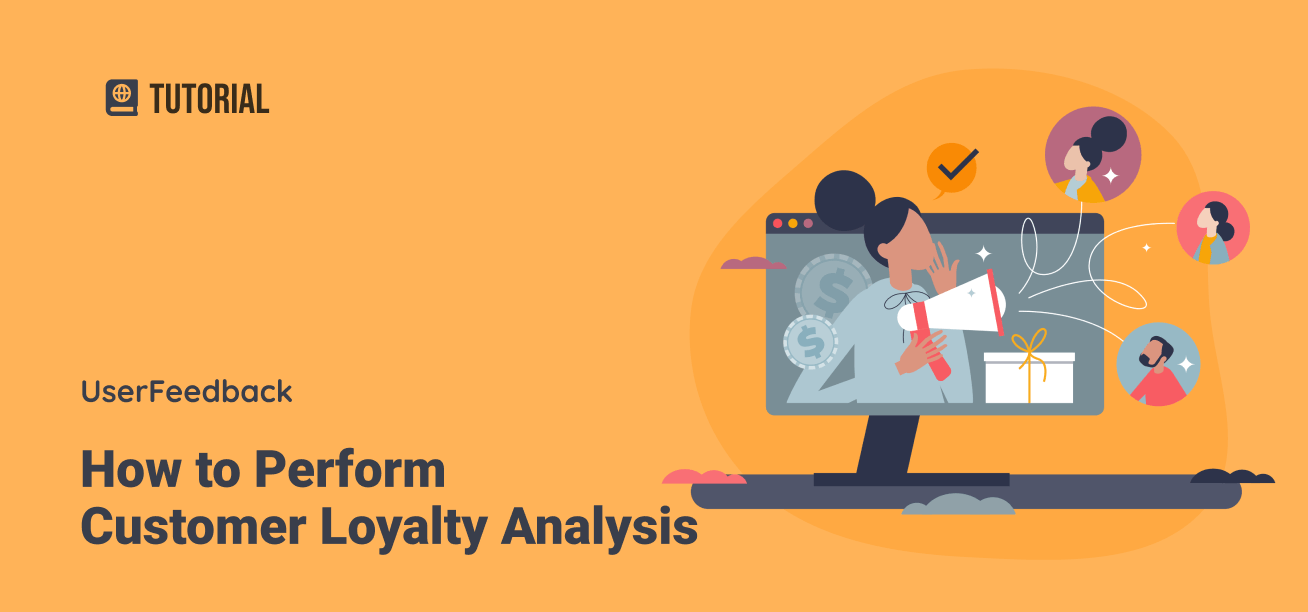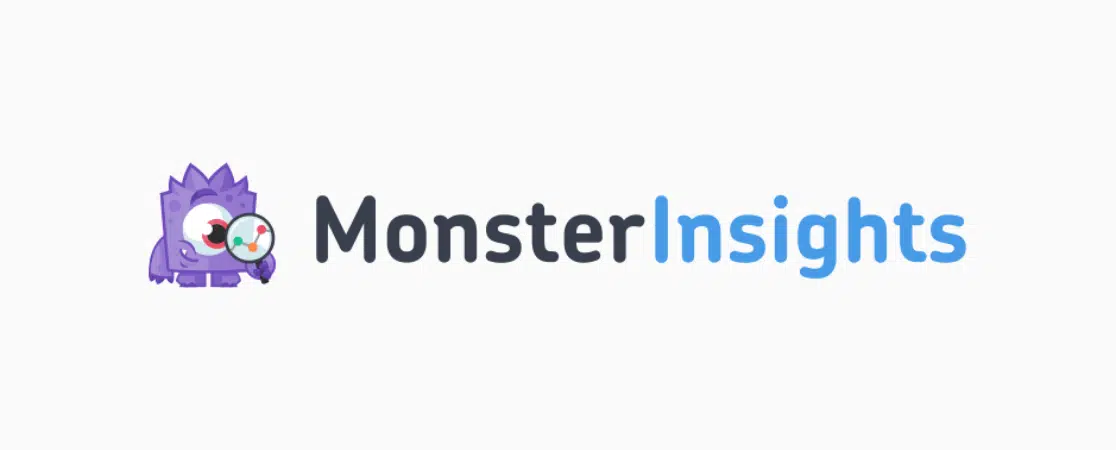Customer loyalty analysis is something I’ve seen transform businesses from struggling with customer retention to building a rock-solid loyal customer base.
I know diving into analyzing customer loyalty might seem overwhelming at first. Trust me, I’ve been there! But don’t worry – I’m here to break it down into simple, actionable steps that anyone can follow, even if you’re just getting started.
In this comprehensive guide, I’ll walk you through everything you need to know about customer loyalty analysis. We’ll explore what it actually means, why it’s absolutely essential for your business’s growth, the most important customer loyalty metrics, and I’ll share practical steps to help you get started.
Here’s what I’ll cover:
- What Is Customer Loyalty Analysis?
- How Can Customer Loyalty Analysis Benefit Your Business?
- How to Perform Customer Loyalty Analysis
- FAQs About Analyzing Customer Loyalty
What Is Customer Loyalty Analysis?
Ever wondered why some customers keep coming back while others disappear after a single purchase? That’s exactly what customer loyalty analysis helps us figure out.
It’s a way to look at all your customer information – things like how often they buy, what they purchase, how they interact with your business, and even what they say about you – to understand what keeps them coming back for more. I like to think of it as connecting the dots between different pieces of customer behavior to create a clear picture.
But here’s what makes it really powerful (and I’ve seen this firsthand): customer loyalty analysis isn’t just about collecting data – it’s about using that information to make smart decisions that keep your customers happy. When you understand why your loyal customers love you, you can do more of what works and fix what doesn’t.
Think of customer loyalty analysis as your business’s GPS – it shows you where you are with your customers, where you want to go, and the best route to get there. And just like a GPS, it helps you avoid wrong turns and finds the fastest path to your destination: a loyal customer base that loves your brand!
How Can Customer Loyalty Analysis Benefit Your Business?

When you really understand what makes your customers tick, amazing things start happening for your business. Here are the main benefits I’ve witnessed:
- Better Understanding of Your Customers: When you analyze customer loyalty, you start seeing patterns you never noticed before. It’s like putting on glasses for the first time!
- Personalized Customer Experience: Customers love it when you ‘get’ them. Proper loyalty analysis allows you to create personal and special experiences.
- Spot Problems Early: It helps you catch issues before they become major problems. You can see when engagement starts dropping or when customers seem less satisfied.
- Smarter Business Decisions: When you know what your loyal customers love (and what they don’t), making business decisions becomes so much easier.
- Save Money While Making More: Keeping existing customers happy is way cheaper than finding new ones. Through customer loyalty analysis, you can focus your resources where they matter most. Plus, loyal customers tend to spend more and recommend your business to others – it’s a win-win!
- Better Marketing Results: When you understand your loyal customers, your marketing becomes more targeted and effective.
When you take the time to analyze customer loyalty properly, you’re investing in your business’s long-term success. Now, let’s explore how actually to do this.
How to Perform Customer Loyalty Analysis
Now that you know exactly what customer loyalty analysis is and how it can seriously benefit your business, it’s time to get your hands dirty.
Next, I’ll cover the most important customer loyalty metrics for you to analyze and exactly how you can get started:
- Customer Satisfaction Score (CSAT)
- Customer Retention Rate
- Repeat Purchase Rate
- Net Promoter Score® (NPS®)
- CLV (Customer Lifetime Value)
- Customer Effort Score (CES)
- Measure Customer Churn
- Evaluate Reviews and Social Media Mentions
1. Customer Satisfaction Score (CSAT)
Let’s talk about one of my favorite ways to measure customer loyalty – the Customer Satisfaction Score (CSAT).
Think of CSAT as a temperature check of how happy your customers are with your product, service, or specific interaction with your business.
Usually, you’ll ask customers something like “How satisfied were you with your experience today?” and give them options to rate their satisfaction on a scale. I typically recommend using a 1-5 scale, where:
- 5 = Very Satisfied
- 4 = Satisfied
- 3 = Neutral
- 2 = Dissatisfied
- 1 = Very Dissatisfied
Here’s the simple math to calculate your CSAT score:
- Add up all the numbers of 4 and 5 responses (the positive ones)
- Divide that by the total number of responses
- Multiply by 100 to get a percentage
For example, if you got 80 responses and 60 of them were 4s or 5s, your calculation would be:
(60/80) × 100 = 75%
That means 75% of your customers are satisfied – pretty straightforward, right?
When to Use CSAT I recommend measuring CSAT:
- Right after a purchase
- Following a customer service interaction
- After delivering a service
- When launching new features
- During key points in the customer journey
Here’s a pro tip if you’re using WordPress: The UserFeedback plugin makes setting up CSAT surveys super simple. It’s the best user feedback tool available for creating surveys because it takes all the technical hassle out of the process.
You can create beautiful popup surveys that look professional and get you the feedback you need – no coding required!
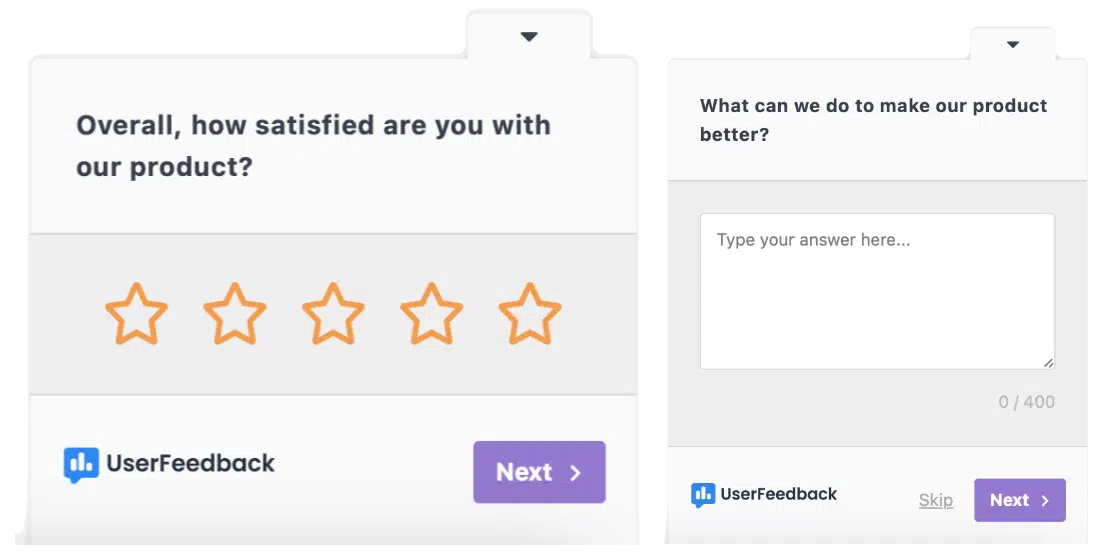
Remember, CSAT is just one piece of the customer loyalty puzzle, but it’s a great place to start. In my experience, regularly checking your CSAT scores helps you stay connected with your customers’ needs and keeps you on track for building stronger loyalty.
Read our full guide on 20 Customer Satisfaction Survey Examples & Templates to Use.
2. Customer Retention Rate
Customer Retention Rate (CRR) shows what percentage of your customers stick around over time.
It’s simple: if you started with 100 customers and kept 75 of them after a year (not counting new ones), that’s a 75% retention rate.
How to Calculate It Here’s the basic formula:
CRR = (E−N)/S × 100
Where:
- E = Customers at the end of the period
- N = New customers during the period
- S = Customers at the start of the period
Quick example: Start with 100 customers, gain 20 new ones, and end with 95.
(95−20)/100 × 100 = 75%
Why it matters:
- Keeping customers is cheaper than finding new ones
- Loyal customers usually spend more
- Helps predict future revenue
- Shows how healthy your business really is
If you’re running a WordPress store, I highly recommend MonsterInsights. It’s the best analytics plugin out there, working seamlessly with WooCommerce, Easy Digital Downloads, and other popular platforms. Just a few clicks, and you’re tracking everything you need!
Remember, a good retention rate varies by industry, but aim for at least 80%. Start tracking this metric today – your business will thank you later!
3. Repeat Purchase Rate
This is one of my favorite metrics because it tells you exactly how many customers return for more!
Simply put, RPR (Repeat Purchase Rate) shows you the percentage of your customers who have bought from you more than once. In my experience, this number tells you a lot about how much people love your products or services.
The formula is super simple:
RPR = (Number of Customers Who Bought More Than Once/Total Number of Customers) × 100
So, if you have 1,000 total customers and 250 of them have made multiple purchases:
(250/1,000) × 100 = 25%
This means 25% of your customers are repeat buyers!
Why it’s important:
- Shows how ‘sticky’ your products are
- Helps predict future sales
- Indicates customer satisfaction
- Points to product-market fit
- Highlights potential loyalty issues
Pro Tip: Remember that what counts as a ‘good’ repeat purchase rate varies by industry. For example, a coffee shop might expect much higher rates than a furniture store. The key is to track your trends over time and work on steady improvement.
4. Net Promoter Score® (NPS®)
I love using NPS® surveys because it asks just one key question: “How likely are you to recommend our business to a friend or colleague?”
It works by customers rating you on a scale of 0-10, and here’s how we group them:
- Promoters (9-10): Your biggest fans
- Passives (7-8): Satisfied but not enthusiastic
- Detractors (0-6): Unhappy customers
Calculating your NPS® is really straightforward:
NPS® = (% of Promoters − % of Detractors)
For example, if you have:
- 60% Promoters
- 20% Passives
- 20% Detractors
Your NPS® score would be: 60% – 20% = 40
You don’t include your passives since they fall in the middle and don’t count.
UserFeedback makes running NPS® surveys super simple! The plugin comes with ready-to-use NPS® templates:
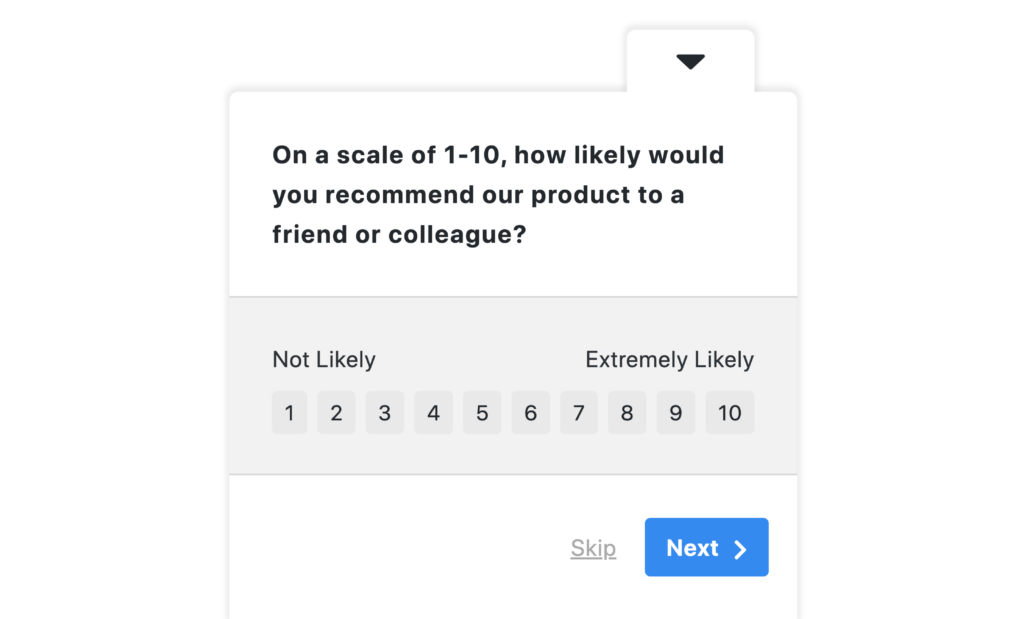
And the best part? It automatically calculates your score and shows you beautiful visual reports of how your score changes over time in the NPS® report:
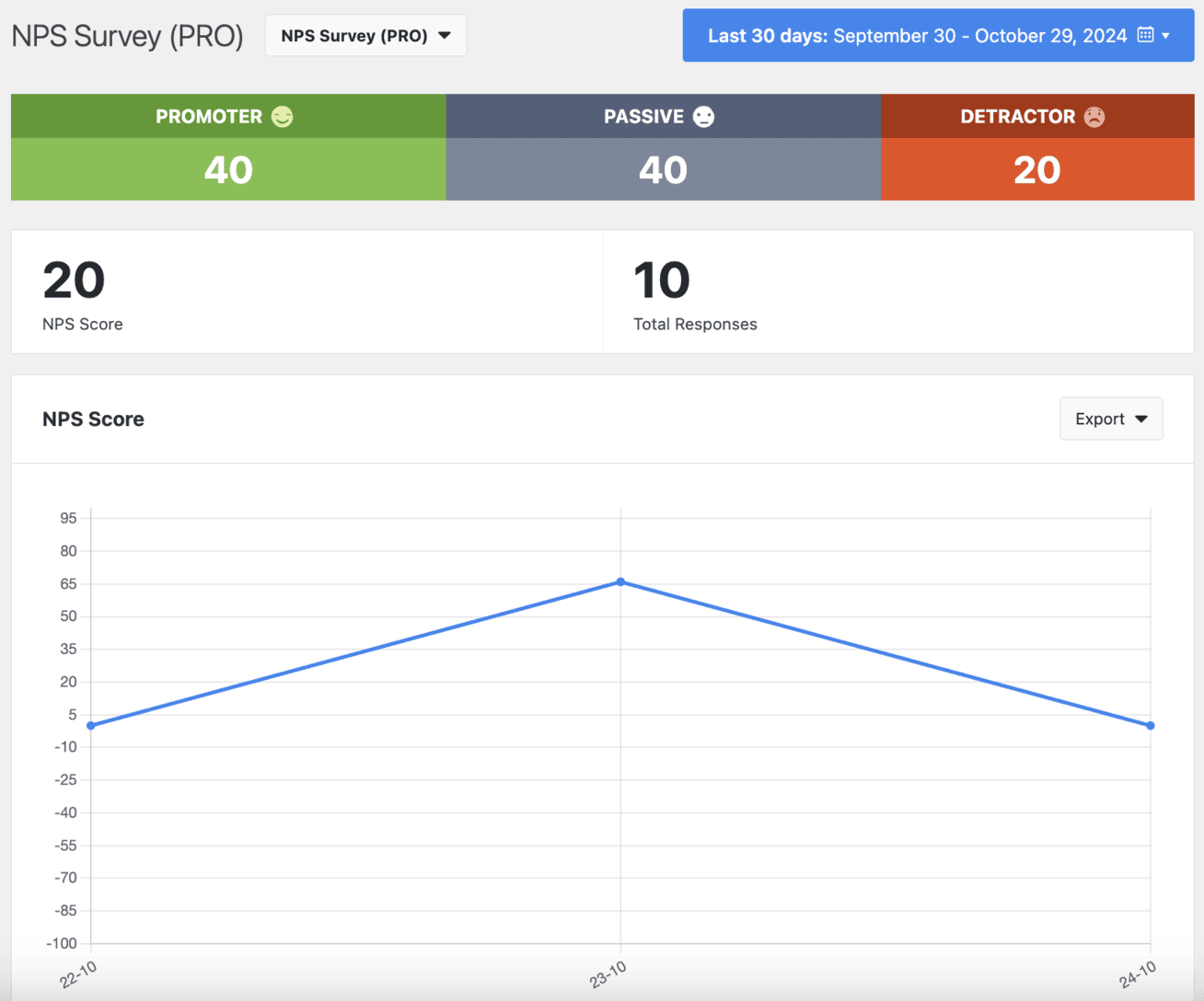
Plus, when you connect it with MonsterInsights, you get even deeper insights by seeing how your NPS® relates to other website metrics. I’ve found this combination incredibly powerful for understanding the full picture of customer loyalty.
What your NPS® tells you:
- How likely customers are to spread the word
- Overall customer satisfaction
- Potential for business growth
- Areas that need improvement
Remember, any NPS® above 0 is good, above 50 is excellent, and above 70 is world-class. But what matters most is improving your score over time!
Check out our Tutorial: Net Promoter Score® (NPS®) Survey in WordPress.
5. CLV (Customer Lifetime Value)
Simply put, CLV tells you how much money a customer is likely to spend with your business throughout your entire relationship. Think of it as calculating the value of a friendship – but with dollars!
Here’s the basic formula:
CLV = Average Purchase Value × Purchase Frequency × Average Customer Lifespan
Let me break this down with a simple example:
If a customer:
- Spends $50 on average per purchase
- Buys 4 times per year
- Stays with you for 3 years
Their CLV would be: 50 × 4 × 3 = $600
Why CLV matters:
- Helps decide how much to spend on acquiring customers
- Shows which customers are most valuable
- Guides marketing and service priorities
- Indicates business health
Remember: Knowing your CLV helps you make smarter decisions about where to invest your time and money. In my experience, businesses that track and work to improve their CLV tend to grow more sustainably!
6. Customer Effort Score (CES)
CES is all about making things easy for your customers! I love this metric because it gets straight to the point: how much work did your customer have to put in to get what they needed?
CES measures how easy (or difficult) it was for customers to handle their business with you. Whether it’s making a purchase, getting support, or finding information – it’s all about the effort they need to put in.
Typically, you’ll ask something like: “How easy was it to solve your problem today?” with a scale (from 1 to 5 or 7):
- 7 = Very Easy
- 1 = Very Difficult
The formula is simple:
CES = (Sum of All Responses/Number of Responses)
For example, if you get these scores from 5 customers: 7, 6, 6, 5, 7
CES = 31/5 = 6.2
That’s a pretty good score – it means customers find you easy to work with!
I typically recommend measuring CES:
- After customer service interactions
- Post-purchase
- Following website navigation
- After using self-service tools
- During checkout process
If you’re using WordPress, UserFeedback makes creating CES surveys super simple. You can place them anywhere on your site – after checkout, in your help center, or on specific pages:
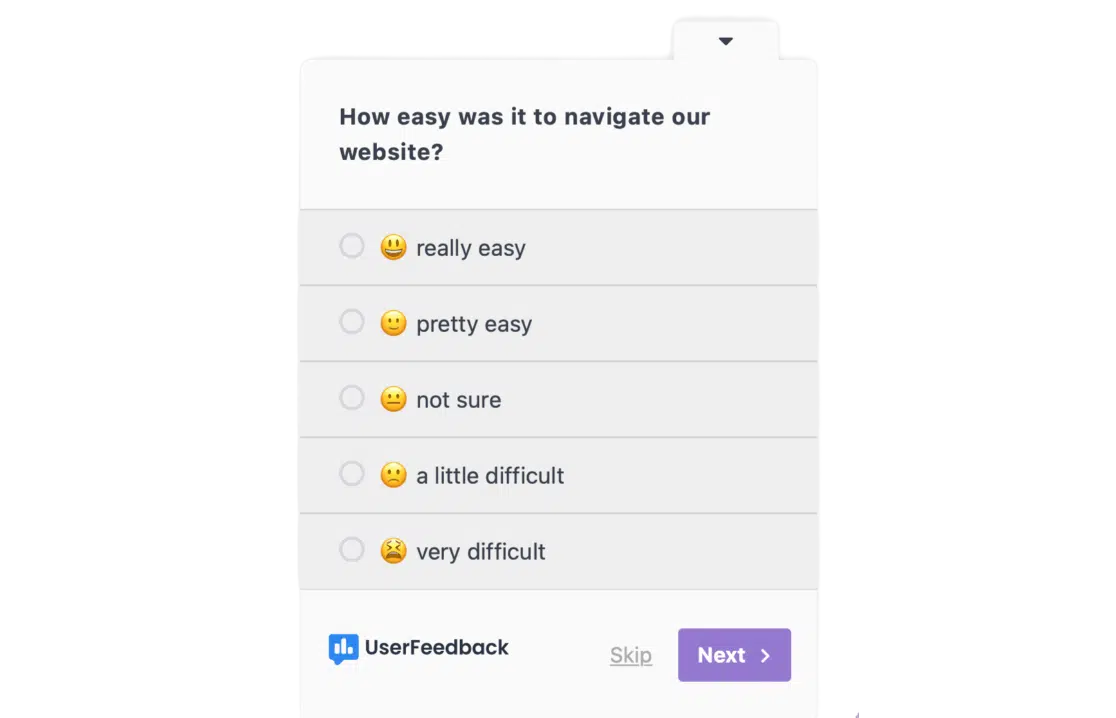
The easier you make things for customers:
- The more likely they are to come back
- The less support they’ll need
- The more they’ll spend
- The more they’ll recommend you
Learn everything about creating CES surveys here: How to Create a CES Survey in WordPress (Step-by-Step).
7. Measure Customer Churn
Churn shows the percentage of customers you lose over a specific time period. I’ve found it’s one of the most important metrics to track because losing customers costs way more than keeping them.
Here’s the simple formula:
Churn Rate = (Lost Customers/Starting Customers) × 100
So, if you start with 200 customers and lose 10:
Churn Rate = (10/200) × 100 = 5% churn rate
Why it matters:
- Shows how well you’re keeping customers
- Helps predict future revenue
- Indicates customer satisfaction
- Reveals potential problems early
Pro Tip: Aim for an annual churn rate under 5-7%. The lower, the better! In my experience, understanding why customers leave is your first step to keeping them around longer.
8. Evaluate Reviews and Social Media Mentions
What others say about you matters more than what you say about yourself! Let me show you why tracking reviews and social media mentions is crucial for understanding customer loyalty.
The numbers don’t lie – here are some eye-opening stats I like to share:
- 93% of consumers say reviews impact their buying decisions
- Customers spend 31% more on businesses with excellent reviews
- 72% of people only take action after reading positive reviews
Social media mentions are like having your ear to the ground – they tell you what customers really think when they’re talking to friends. Whether it’s praise, complaints, or suggestions, this is raw, honest feedback you can’t ignore.
UserFeedback makes collecting reviews super simple on your WordPress site. I love their new conditional redirect feature – it lets you automatically send happy customers to your review page after they complete a survey.
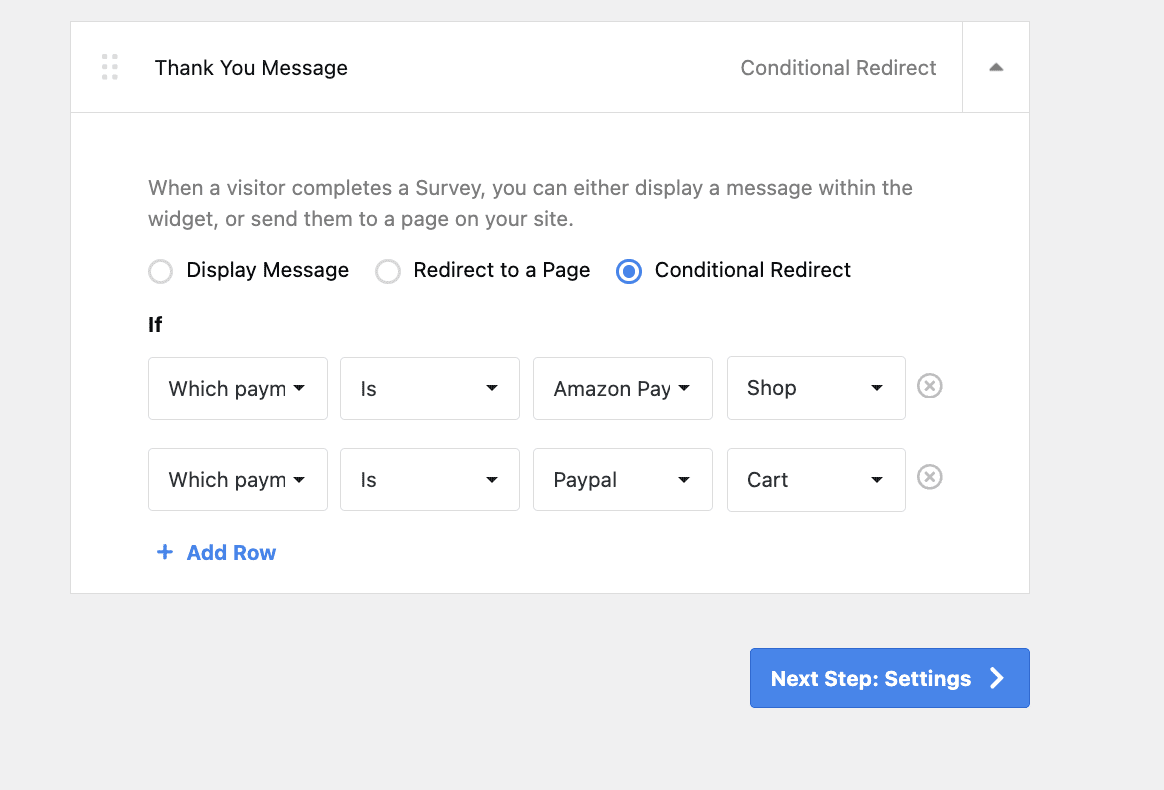
Smart, right?
Remember: Don’t just collect reviews – respond to them! It shows you’re listening and care about customer feedback. In my experience, this simple act can turn an unhappy customer into a loyal one.
Learn how to effectively collect reviews here: How to Ask For a Review (12 Best Ways + Examples)
FAQs About Analyzing Customer Loyalty
Below, I’m answering some common questions related to this whole customer loyalty topic:
What are the 4 C’s of customer loyalty?
The 4 C’s are Communication, Customer Service, Consistency, and Credibility.
From my experience, these form the foundation of building loyal relationships with customers.
Communication keeps customers informed, great service solves their problems, consistency builds trust, and credibility makes them believe in your brand. These elements work together to create lasting customer relationships.
How do I measure customer loyalty?
I recommend using a combination of key metrics: Net Promoter Score (NPS) to measure recommendation likelihood, Customer Retention Rate to track who stays, Repeat Purchase Rate to see who buys again, and Customer Lifetime Value to understand long-term worth. UserFeedback makes tracking these metrics super easy on WordPress sites.
What is the key to customer loyalty?
The secret sauce is consistently delivering value while building emotional connections. I’ve found that customers stay loyal when they feel understood and appreciated. It’s about going beyond transactions to create meaningful experiences. Focus on solving problems, providing excellent service, and genuinely caring for customer needs.
What are the three phases of loyalty?
- Phase 1 – Cognitive Loyalty: This is the logical phase where customers stick with you based on basic information like prices and features. It’s the most fragile type of loyalty because it’s purely rational and can easily be swayed by better deals.
- Phase 2 – Affective Loyalty: This is when customers develop positive feelings about your brand. They’ve had good experiences and started to feel connected. It’s stronger than cognitive loyalty because emotions are harder to break than logical decisions.
- Phase 3 – Behavioral Loyalty: This is the golden phase – when customers become hardcore fans who take action. They’re not just coming back; they’re recommending you to others, defending your brand, and staying loyal even when competitors try to lure them away.
That wraps up my comprehensive guide to customer loyalty analysis. I really hope you liked it and found it helpful. I recommend you also check out these other resources:
- 28 Great Customer Service Survey Question Examples
- How to Create a B2B Buyer Persona (+ Template and Examples)
- 44 Customer Survey Questions + Guide to Meaningful Feedback
- How to Get Customer Feedback Online (6 Best Ways)
Not using UserFeedback yet? Get started today!
And don’t forget to follow us on X and Facebook to learn more about customer satisfaction and user feedback.
